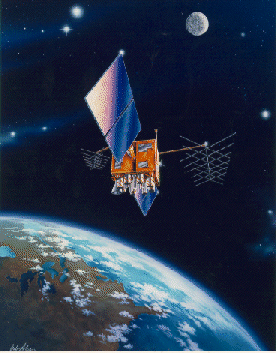
The U.S. Air Force is responsible for the Navstar Global Positioning System (GPS) which enables all three military services and civilian users to determine: location in three- dimensions, velocity, and precise time anywhere in the world. The first GPS space vehicles were in orbit by 1978. Source: Martin Marietta Astro Space
For centuries, mariners used stars and other heavenly bodies for navigation. A modern, hightech version of this technique allowed U.S. troops in the Persian Gulf War to operate in a desert wilderness with pinpoint accuracy. Now it is stimulating an enormous variety of civilian applications--from James Bond-style personal navigators to aircraft avoidance systems--and fueling a huge new commercial market.
This modern navigational miracle, known as the Global Positioning System (GPS), can instantly and automatically tell users their location and altitude to within about 30 feet anywhere on Earth. Instead of stars, the GPS system uses 24 satellites that each circle the Earth in precisely determined orbits every 12 hours. Instead of starlight, it uses radio waves that cannot be blocked by clouds. And instead of a mariner's sextant, the GPS system depends on computer chips, miniaturized radio receivers, and--especially--ultra-precise atomic clocks. Such clocks, carried on each satellite, keep time to within millionths of a second over an entire year. Such accuracy is at the heart of the GPS system, because it allows the satellites to broadcast timing signals. The signals from several satellites can be compared by a receiver and electronically translated into a precise determination of its position.
Atomic clocks were not, of course, invented with such an application in mind. In fact, they arose from efforts to answer fundamental questions about the nature of the universe. Testing the basic laws of physics, such as Einstein's theory of general relativity, turned out to require much more accurate clocks than were available 30 years ago. So university physicists set out to develop them, and succeeded both in verifying Einstein's predictions and in making major advances in the technology of time-keeping. Outside of physics, no great need for ultra-precise clocks was foreseen; but, as so often happens, the advance opened up unpredictable opportunities.
The Global Positioning System was initially developed by the U.S. Air Force for military navigation, for which it has already proved its worth. Many important civilian applications have already emerged--coastal navigation, emergency rescue, tracking commercial vehicles--and GPS use is expanding rapidly. Last year, foreshadowing the impact of the GPS system on aircraft avoidance and navigation, a Gulfstream airplane made a flawless approach to Washington's National Airport using only GPS guidance. Inexpensive receivers to guide backpackers in remote areas or to guide automotive travellers along unfamiliar routes are beginning to appear.
Over 160 manufacturers are developing GPS-based systems worldwide for a new multibillion dollar market. The investment in atomic clocks made decades ago was a seminal part of this development and illustrates the remarkable dividends to society that fundamental research can provide. Today's investments in atomic research, such as trapping and cooling atoms in webs of laser light, have improved precision by orders of magnitude compared with that of GPS clocks. In the laboratory, this basic research is pushing our understanding of physical laws to new limits. In the marketplace, it will undoubtedly stimulate new technologies with surprising societal applications.